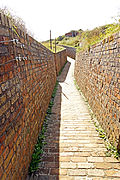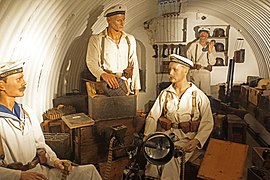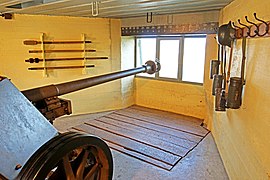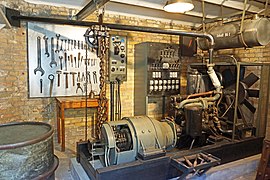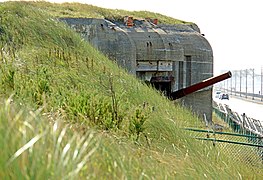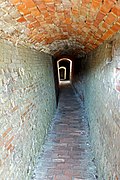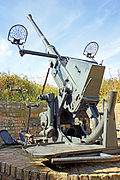Freilichtmuseum Atlantikwall
 Bunker und Geschützstellung des Atlantikwalls | |
| Daten | |
|---|---|
| Ort | Ostende |
| Art | |
Das Freilichtmuseum Atlantikwall (niederländisch Openluchtmuseum Atlantikwall) ist ein Kriegs- und Freilichtmuseum in der belgischen Provinz Westflandern unmittelbar westlich der Hafenstadt Ostende. Es hat den Atlantikwall zum Thema, der hier während des Zweiten Weltkriegs von den deutschen Besatzern gebaut wurde, um diese Gebiete vor einer alliierten Invasion zu schützen.
Das Museum zeigt eine Reihe von Bunkern und Gräben, die teilweise in ihren ursprünglichen Zustand zurückversetzt wurden. Ferner werden auch Stellungen aus dem Ersten Weltkrieg präsentiert, die Anfang 1915 dort errichtet worden waren. Dazu gehören unter Stahlkuppeln platzierte Kanonen, die durch eine Feldbahn mit in den Dünen versteckten Munitionskammern verbunden waren.[1]
Belgische 12-cm-„Beute“-Kanone
Überbleibsel eines Funkmessgeräts „Würzburg-Riese“ und Scheinwerfer
Belgische „Beute“-Flak
Weblinks
- Atlantikwall, Website des Museums
Einzelnachweise
- ↑ Atlantikwall Museum (niederländisch), abgerufen am 30. September 2020.
Koordinaten: 51° 12′ 2″ N, 2° 50′ 50″ O
Auf dieser Seite verwendete Medien
Autor/Urheber: Dennis G. Jarvis , Lizenz: CC BY-SA 2.0
Display in the museum - Enigma Machine In Oostende near the beaches is a well-preserved part of Hitler's Atlantic Wall. Sixty constructions (bunkers, storage facilities, personnel quarters, machinegun nests) dating from both World Wars are interconnected by two kilometers (1.24 mi) of trenches.
Autor/Urheber: Dennis Jarvis from Halifax, Canada, Lizenz: CC BY-SA 2.0
PLEASE, NO invitations or self promotions, THEY WILL BE DELETED. My photos are FREE to use, just give me credit and it would be nice if you let me know, thanks. A hardened bunker that overlooked the beach.
Autor/Urheber: Dennis Jarvis from Halifax, Canada, Lizenz: CC BY-SA 2.0
PLEASE, NO invitations or self promotions, THEY WILL BE DELETED. My photos are FREE to use, just give me credit and it would be nice if you let me know, thanks. A bunker that contains another German World War II PAK 40 anti-tank gun. The room has a variety of support items and men to operate the gun.
Autor/Urheber: Paul Hermans, Lizenz: CC BY-SA 3.0
Een stelling van het Openluchtmuseum Atlantikwall te Raversijde, Oostende, België, met een Belgisch 12 cm K370 kanon
Autor/Urheber: Paul Hermans, Lizenz: CC BY-SA 3.0
Een afstandsmeter in het Openluchtmuseum Atlantikwall te Raversijde, Oostende, België
Autor/Urheber: Paul Hermans, Lizenz: CC BY-SA 3.0
Een deel van het Openluchtmuseum Atlantikwall te Raversijde, Oostende, België
Autor/Urheber: Dennis Jarvis from Halifax, Canada, Lizenz: CC BY-SA 2.0
4 cm Flak 28 (Bofors) - Antiaircraft Gun..
Autor/Urheber: Dennis Jarvis from Halifax, Canada, Lizenz: CC BY-SA 2.0
PLEASE, NO invitations or self promotions, THEY WILL BE DELETED. My photos are FREE to use, just give me credit and it would be nice if you let me know, thanks.
This place was fantastic t visit and there is a lot more to see than what I have shown but our time was limited.
Passage between bunkers.Autor/Urheber: Dennis Jarvis from Halifax, Canada, Lizenz: CC BY-SA 2.0
PLEASE, NO invitations or self promotions, THEY WILL BE DELETED. My photos are FREE to use, just give me credit and it would be nice if you let me know, thanks. Old radar dish and a searchlight is on display.
Autor/Urheber: Dennis Jarvis from Halifax, Canada, Lizenz: CC BY-SA 2.0
The Atlantic Wall stretches from Norway to the border of Spain, with a length of nearly 5300 kilometers (3293 miles). The Atlantic Wall had to withstand an invasion of occupied Europe by the Allies. The Saltzwedel Battery contains several bunkers with submarine guns, anti-aircraft guns, searchlights and several cannons.
Autor/Urheber: Dennis Jarvis from Halifax, Canada, Lizenz: CC BY-SA 2.0
PLEASE, NO invitations or self promotions, THEY WILL BE DELETED. My photos are FREE to use, just give me credit and it would be nice if you let me know, thanks.
Generator room that supplied electricity to the bunkers and facilities.Autor/Urheber: Dennis Jarvis from Halifax, Canada, Lizenz: CC BY-SA 2.0
PLEASE, NO invitations or self promotions, THEY WILL BE DELETED. My photos are FREE to use, just give me credit and it would be nice if you let me know, thanks.
World War I, soldiers of the German Naval Corps in the bombshelter in 1916. The shelter was built with sheets of iron covered with large amounts of concrete and sand.